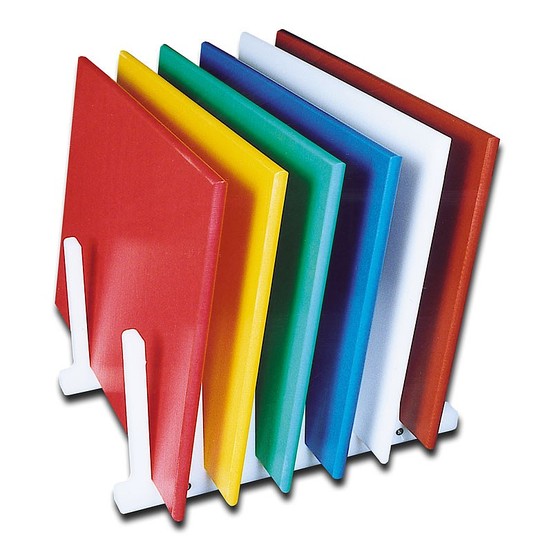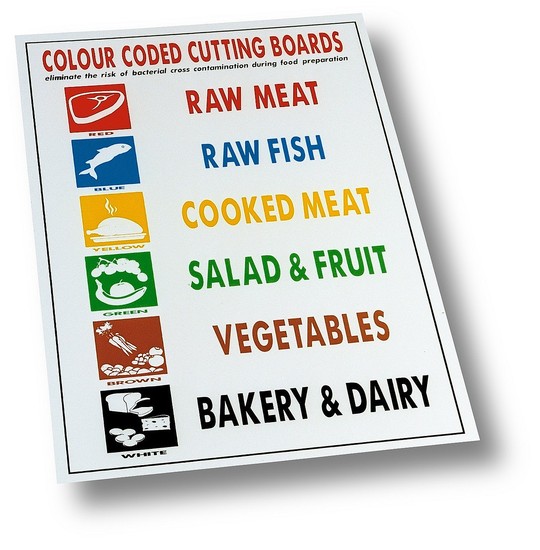A Facebook feud where chefs discussed how one of them was 'told off' for using the wrong coloured chopping board for preparing meat struck our attention. So, we took to finding out what guidelines you should be following when using chopping boards.
Guidlines
The catering equipment suppliers association (CESA) says that you an avoid allergic reactions by “removing or reducing cross contamination which may arise from shared equipment” one way of doing this is by using colour coded knives and chopping boards.
Kieth Warren, director of CESA, says: "My understanding is that it is not a regulation that you have to use a particular colour with a particular food product. It is not mandated, but there is guidance that suggests that certain colours should only be used with certain foods and that prevails across the industry."
This current accepted coding in the UK is:
Yellow – Cooked meat
Red – Raw meat
White – Bread/Dairy
Blue – Raw fish
Green – Fruit/Salad
Brown – Raw Veg
Julian Edwards, CEO at Allergen Accreditation, agrees: "It is best practise to set a guide for chefs when they prepare different foods, especially for chopping. This is because we must all actively protect consumers and reducing the chance of cross contamination by using coloured chopping boards is one way to achieve this."
The Law
When it comes to the law regarding chopping boards, Julian says: "Technically any colour can be used for any product allowing that it is then cleaned and disinfected before being used for another product."
Though the law does not say any particular colour has to be used for certain foods, Keith says that it is still important that the kitchen sticks to one code:
"Some will bring knowledge from other jobs where they use red chopping boards for red meat, so if they move into an establishment where they use red chopping boards for something else, it's going to cause the potential for contamination."
Julian agrees, pointing out that problems could arise if a member of the public that knows the code sees a chef using a different colour than expected. Even if the board is perfectly safe and disinfected, he says: "it could lead to a complaint or query and could present the business as being un-professional."
However, using different coloured boards is not a substitute for attentive cleaning since chefs also need to avoid allergen contamination, not just food poisoning. +3
+3
The Allergen Accreditation say: "These need to be cleaned and disinfected between processes as well as not left out dirty for long periods of time; a kitchen is a warm place and bacteria will grow."
Julian adds: "If we take a white board- for breads and dairy use... once the white board has been used for bread slicing it needs to be cleaned and disinfected before any cheese is sliced on it. (When the cheese is meant for a wheat free product for example)"
Training
The CESA director insists that staff training is key, he says: "What we’re really looking to do is to prevent someone who’s got an allergy to one of those in the list of 14 allergens getting it in their food or drink. So, it’s about having a structure and system in place within the kitchen, with all of the staff knowing what that system and structure is to ensure that it doesn't happen."
Some caterers have taken to using purple chopping boards, knives and areas to prepare anti-allergen specific foods. Though this does not completely eliminate cross contamination,
Julian says: "It does add another dimension to chef awareness of avoiding cross contact of allergens and like the use of general colour coded boards can be a useful tool!"
 The Allergen Accreditation requires kitchens to have written policies, irrespective of the choice of chopping boards. Their CEO says: "This can be prepared and issued to all staff as a training session that they all sign up to. Record this training!"+3
The Allergen Accreditation requires kitchens to have written policies, irrespective of the choice of chopping boards. Their CEO says: "This can be prepared and issued to all staff as a training session that they all sign up to. Record this training!"+3
Keith adds that it is not just kitchen staff that need to be allergen trained, but the front of house too: "[They] have got to know what they're dealing with, what the allergen issues are because they are the communicator to what's going on to the back of house and the customer."
By Kellie Wyatt



 The Allergen Accreditation requires kitchens to have written policies, irrespective of the choice of chopping boards. Their CEO says: "This can be prepared and issued to all staff as a training session that they all sign up to. Record this training!"
The Allergen Accreditation requires kitchens to have written policies, irrespective of the choice of chopping boards. Their CEO says: "This can be prepared and issued to all staff as a training session that they all sign up to. Record this training!"












Katie Pathiaki
Jan Goj
There are no comments yet.
You could be commenting on this if you had an account! Click here to sign up.